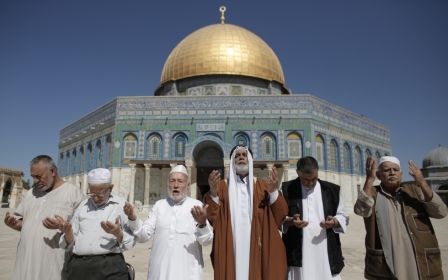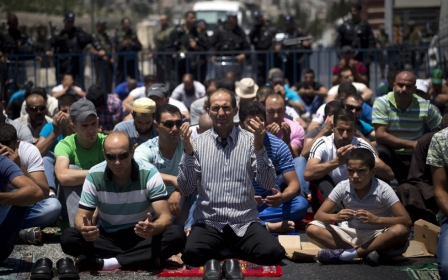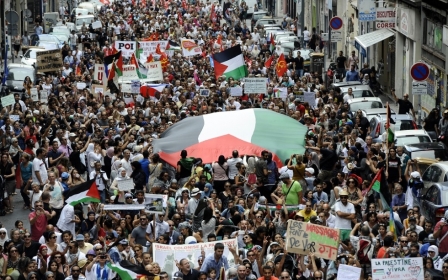As holy days clash, Jerusalem calmer than ever

The authorities had closed all the crossings from the West Bank to Israel for Palestinians, but as a holder of a foreign passport, I was allowed through Bethlehem’s Checkpoint 300 on Saturday morning. The closure meant there were no buses, so I somewhat reluctantly began my six-mile walk to Jerusalem, a city I was sure would see heavy tensions on the Clash of the Holy Days, the first time in over 30 years that the Jewish fasting holiday of Yom Kippur coincided with the Muslim feast of Eid al-Adha.
As I made my way north, the usually car-lined streets were almost completely abandoned. Barriers were set up at each intersection, accompanied by a police car or two.
Israeli police were certainly prepared for potential “friction” between Muslims and Jews on this day - a day on which Jews would refrain from driving while Muslims would be running all over the city celebrating and visiting family. In years past, ultra-religious Jews have hurled rocks at any cars on the road, even ambulances, buses, and police cars. In 2008, riots broke out in Acre after a Palestinian citizen of Israel drove his car while blaring music in a religious Jewish neighbourhood. With that in mind, days ahead of the coinciding holidays, police spokeswoman Luba Samari issued a statement.
"Police reinforcements will be deployed in all areas where Jews and Arabs live alongside each other, to prevent friction and allow the two communities to observe their holidays without problems,” Samari said.
“Regional police commanders will be in touch with political and religious leaders of the two communities to encourage mutual tolerance and respect.”
“The police will act with an iron fist against anyone who might engage in provocation, incitement to violence or disturbing public order,” she added.
But when I finally arrived, instead of the standoff everyone was expecting, I found Jerusalem to be the calmest I’d ever seen it. Minus your odd group of Palestinian boys taking to the empty streets to ride bicycles, a flock or two of foreign tourists, and an occasional cute old Jewish couple, the West Jerusalem neighbourhoods on the way to the Old City were empty and quite serene.
The Old City itself, though typically bustling, had a similar air of calm. Just inside Damascus gate, the few venders who stayed open smoked cigarettes and leaned against their stands while a group of Israeli police officers sat, bored, as Palestinian men and women walked past in their best outfits which they had purchased specifically for the Eid.
Meanwhile, the East Jerusalem bus station was running normally, if at a reduced capacity, and I wondered if the drivers had experienced any of the stone-throwing incidents they had in the past.
“No,” a bus driver told me. “It’s been calm today. They closed off all the Jewish areas to traffic so there won’t be any issues.”
If not in the Old City or in the heart of East Jerusalem, I thought to myself, there must be some tensions in Silwan.
The neighbourhood - which for the past several years has had to deal with periodic takeovers of its Palestinian residences by Israeli settlers, thanks in large part to the right-wing Ir David Foundation - had just days before witnessed yet another such traumatic event. Settlers came to Silwan overnight on 30 September under armed guard by Israeli forces and occupied over 20 empty apartments, even forcibly evicting one Palestinian family. I headed to the neighbourhood to take a look.
But all I found were a few children wearing fancy clothes and waiting for their parents to come take them to their relatives’ houses, in addition to a couple groups of merry visitors headed for an Eid celebration. When I asked two of them if there had been any issues with the settlers today, they responded with a definitive “no.”
“We can respect people’s religious practices on our land,” one of them told me, in a hurry to sit down with his family for the Eid.
I headed back up the hill toward the Old City as the sun was coming down. There was nothing to see, I concluded. Nothing but a Jerusalem devoid of its trademark - swarms of all sorts of people. With public transportation to Bethlehem still halted, I began my hike back to the checkpoint.
Across the board, my visit to Jerusalem on the Clash of the Holy Days was a pleasant surprise. Indeed, with no “Jewish-Arab” tensions to report on, Israeli media focused on bike accidents. Perhaps we shouldn’t have expected anything so dramatic (although it was admittedly hard not to after a summer of kidnappings, murders, and military assaults). Instead, the residents of the holy city of Jerusalem, on separate holy days that happened to coincide, seemed to be busying themselves with what most of us spend our time doing on holidays - gathering with family, enjoying time off work, and trying to forget our troubles. Now what should be so shocking about that?
New MEE newsletter: Jerusalem Dispatch
Sign up to get the latest insights and analysis on Israel-Palestine, alongside Turkey Unpacked and other MEE newsletters
Middle East Eye delivers independent and unrivalled coverage and analysis of the Middle East, North Africa and beyond. To learn more about republishing this content and the associated fees, please fill out this form. More about MEE can be found here.




